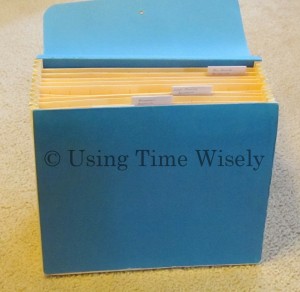 This past week, I brought file box 1 with me to start going through slot by slot checking that all the information is updated and current. Every time I thought I would get a few minutes to work, I ended up needing to address something else. Therefore, I will try again this coming week. 😉
This past week, I brought file box 1 with me to start going through slot by slot checking that all the information is updated and current. Every time I thought I would get a few minutes to work, I ended up needing to address something else. Therefore, I will try again this coming week. 😉
If you are struggling finding time to organize your important documents, take a deep breath as this is a marathon, not a sprint. Keep this task on your radar.
Find a time that works for you. For me, I already spend time twice a month working to pay our bills, file documents, etc. During those times, I work on our important documents.
Just find what works for you. Don’t worry about the past. Just focus on what you can do this week.
Within our investment category, we have looked at U.S. Treasury Savings Bonds, cash accounts, documents for adult accounts, and documents for children’s accounts. For each of our cash accounts, we have a beneficiary designation form on file. Though each financial organization has their own process, of which you might need to ask, designating a beneficiary for each of your accounts protects your investment.
Part 3: Beneficiary Designations
Financial Institution #1
At our preferred financial institution, we designated our beneficiaries when we opened our accounts. The Payable-On-Death Account (POD) In Equal Shares form required the following information:
- Account number
- Account Suffix(es) – checking and savings
- Account owner’s name
- Account owner’s social security number
- Primary beneficiary’s name, address, date of birth, social security number, and percentage of beneficiary (You can choose multiple primary beneficiaries, but the total must equal 100%.)
- Contingent beneficiary’s name, address, date of birth, social security number, and percentage of beneficiary (You can also have multiple contingents – payable only if there is no surviving primary, but the total of the percentages must equal 100%.)
- Signatures of all account holders
Upon setting up our estate planning documents, I submitted new Payable-On-Death Account (POD) In Equal Shares forms for each of our accounts to keep all the primary and contingent beneficiaries the same.
I keep a copy of those forms for verification. Also, I confirm our current designations annually by making a call and checking on each of our 5 accounts.
Financial Institution #2
For our second financial institution, we had to ask for beneficiary designation information. We were directed to the branch manager to get the proper Payable On Death Agreement which required the following details:
- Account number
- Account owner’s name and signature
- Joint owner(s) name(s) and signature(s)
- Primary beneficiary’s name, relationship to account holder, address, date of birth, social security number, and telephone number (For this institution, they do not usually authorize contingent beneficiaries. However, I adjusted the form indicating primary and contingent beneficiaries.)
Though I have not changed our beneficiary designations with our second financial institution, I still check annually to confirm that our designations have not been altered.
To protect our investments, we establish beneficiary designations on each of our accounts. Though some institutions automatically setup beneficiaries, you may need to research and ask for your designations.
As you organize your important documents, check for beneficiary designations for your investments. If you don’t find any, then contact your financial institution to inquire about their policy and how to designate your beneficiaries.
You have safeguarded your investments within your financial institution, so make sure those investments are there when you are no longer available. Happy designating!
Question: How does your financial institution handle beneficiary designations?